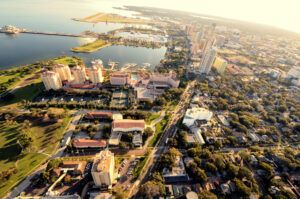Anne Pollack Speaks about Development in the St. Pete Coastal High Hazard Area
Yesterday, attorney Anne Pollack spoke with Chris Steinocher of the St. Petersburg Chamber of Commerce and Joe Hamilton of the St. Pete Catalyst on their “Coronavirus Impact Insights” podcast about the proposed changes to development regulations for St. Petersburg’s much expanded Coastal High Hazard area. The conversation can be found here.
In St. Pete and around the country we are dealing with issues of affordable housing and the need for jobs, especially after the devastation of the coronavirus pandemic. But those issues of place and space also mean we have to proactively deal with the effects of climate change – including increasingly dangerous and damaging hurricanes, and more regularly, increased sea level rise and coastal flooding.
The issues of sustainability and resiliency – both in terms of the environment and with our economy – are issues Anne and the Firm have been focusing on, both in the law practice and through Anne’s role as Chair of the Public Policy Council of the St. Petersburg Chamber of Commerce, and in her role last year as Chair of the Chamber’s Sustainability Committee.
The Coastal High Hazard area (CHHA) is defined generally as the area most likely to be significantly damaged by wave action from storm surge. This is changed periodically thanks to better data, technology, and changes over time to land itself, and in 2016 FEMA once again updated the flood maps and the boundaries of that defined CHHA. This time, however it was a big change. It went from covering about 22% of St. Pete, to covering a whopping 41%.
The issue in St. Pete is that the City’s Comprehensive Plan doesn’t allow increased density in the CHHA. There’s no wiggle room on this. In the past, it didn’t matter as much, because much of the land was public land or single family. But now, the expansion means that the CHHA includes areas that the City had targeted well before this change, for economic development, job growth and redevelopment, as well as affordable housing. These areas include:
-
- Innovation District, USF St. Pete, the Skyway-Marina district, much of 4th North (from the Howard Frankland Bridge all the way down to 54th Ave.); the Gateway district, including Jabil’s property, Carillon Office Park, including the home of Raymond James and Echelon Town Center, most of north Martin Luther King, Jr. Blvd.
We’re no longer just talking about the lands closest to our coasts, and limiting development there could have a potentially deleterious effect on economic development and affordable housing construction in those areas.
The City is now working on efforts to amend the Comprehensive Plan to allow increased density (on a case by case basis), while changing the Code to require that the buildings that are allowed are constructed to be more resilient to storm surge, flooding and wind, that mitigation for service and infrastructure needs created by storm events is provided, and that planning for evacuation before the storm and reentry after the storm is included as part of the development plans. The stronger design standards would apply to all new residential multi-family development with the CHHA, even those that don’t require a comprehensive plan amendment to increase density. This is a big step towards enforcing increased resiliency to protect our residents and businesses.
People keep moving to St. Pete, and if the expanded area of the CHHA can’t be redeveloped, there could be some major issues going forward given the limited area left to redevelop:
- It’s likely to be more expensive to develop outside the CHHA because of the limited amount of land available for increased density
- There is a much greater likelihood of gentrification because of the movement of coastal property owners and developers to the more limited “higher ground”
- It will be more expensive to build anything within the CHHA, hindering commercial development and redevelopment and affordable housing, given that development must deal with increased construction standards even without the City’s changes, but the limitation on increase in residential units will make it difficult to make an economic return, and the limitation on rezoning to zoning districts that allow more commercial intensity but also allow more residential density) will keep commercial development from proceeding
- With increased costs on both sides of the CHHA line, less housing, both affordable and market, is expected to be constructed. Supply is at record lows in Tampa Bay and this is what’s needed the most now.
- Ultimately, this provides for less diversification of the City’s economic base at a time when we need to make it easier to have more diversity throughout our City.

